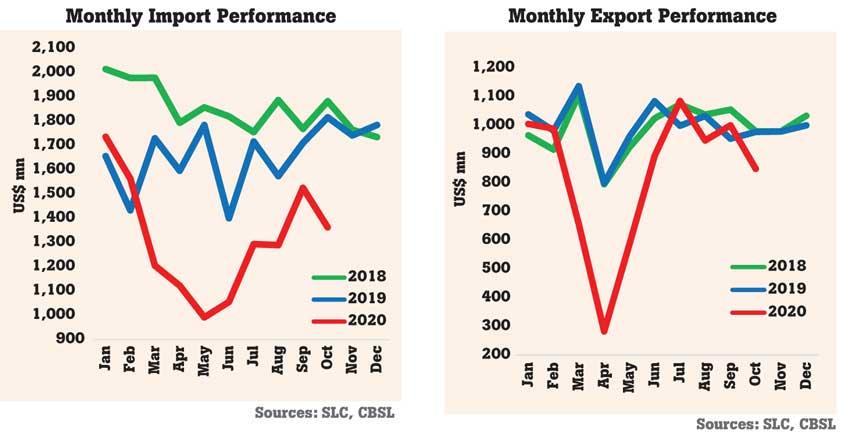15 Dec 2020 - {{hitsCtrl.values.hits}}

Improvement in Sri Lanka’s external sector performance continued in October as well with the trade deficit narrowing further largely due to restrictions imposed on non-essential imports, and the lower oil bill.
Sri Lanka also settled a US$ 1 billion sovereign bond in early October.
Sri Lanka recorded a deficit of US$ 514 million in the trade account in October, which was significantly lower than the deficit of US$ 838 million recorded in October 2019.
The improvement in the trade balance was due to the decline in imports by US$ 453 million, which was greater than the US$ 129 million decline in exports.
The cumulative deficit in the trade account from January to October 2020 narrowed to US$ 4.85 billion from the deficit of U$$ 6.45 billion in the same period in 2019.
The biggest contributing factors for the narrowing of trade deficit were the over US$ 1 billion decline in fuel imports, over US$ 520 million decline in textile and textile article imports, US$ 425 million decline in building material imports and over US$ 369 million decline in personal vehicle imports.
Meanwhile, Sri Lanka’s exports in October fell 13.2 percent from a year ago to US$ 848.4 million, affected by the resurgence of COVID-19 in the country in the early part of the month.
The industrial exports in October fell 16.9 percent from a year ago to US$ 633.3 million with textile and garments exports falling 18.9 percent to US$ 358.2 million.
“However, export earnings from plastics and articles and rubber products increased, led by their sub categories related to personal protectiveequipment (PPE) products such as plastic clothing articles, surgical and other gloves,” the Central Bank said.
Agriculture exports in October edged up by 0.6 percent from a year ago to US$ 211.4 million, led by higher coconut exports.
Tea exports fell 1.4 percent from a year ago to US$ 112.2 million.
Cumulative exports earnings for the 10 months of the year fell 16.7 percent to US$ 8, 293.4 million.
Meanwhile, import expenditure in October fell 24.4 percent form a year ago to US$ 1, 139.4 million with all three main import categories recording declines.
Sri Lanka spent US$ 223.4 million on fuel imports in October, down 27.5 percent from a year ago. For the 10 months of the year, Sri Lanka’s oil bill fell 34.3 percent to US$ 2, 128.6 million.
Investment goods imports in October, which include machinery & equipment, building materials and transport equipment, fell 24.9 percent to US$ 293.5 million.
Meanwhile, in other major inflows to the current account, workers’ remittances continued to increase for the fifth consecutive month.
Workers’ remittances recorded a growth of 3.9 percent in October to US$ 631 million. This increase led the cumulative earnings in workers’ remittances to record a growth of 2.6 percent to US$ 5,680 million during the period from January to October 2020, in comparison to the corresponding period of 2019.
19 Nov 2024 57 minute ago
19 Nov 2024 1 hours ago
19 Nov 2024 3 hours ago
19 Nov 2024 5 hours ago
19 Nov 2024 5 hours ago